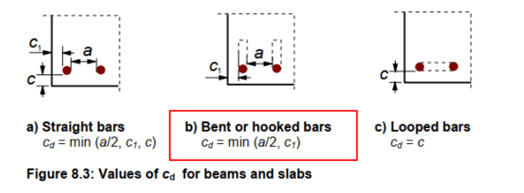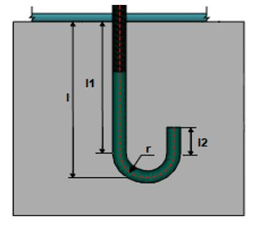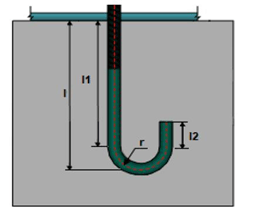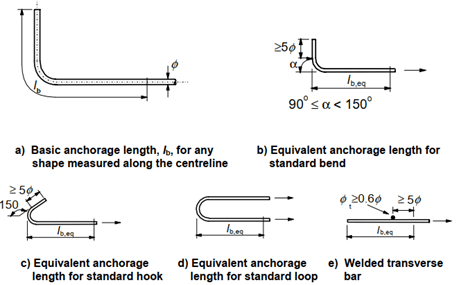For the Base Plate and Tubular Base Plate joints, designed with Advance Design Steel Connections, to determine the bond resistance of anchors subjected to tension, an anchorage length needs to be computed.
The anchorage length calculation has changed:
for the French localization (French design annex), the anchorage length will be
computed according to both CNC2M and EC2 recommendations; the smallest
length will be used to compute the bond resistance.
for the localizations, Eurocode 2 recommendations will be used to determine
the anchorage length.
The main steps which are implemented in the calculation, both for straight and hooked
anchors are the following:
1. The basic required anchorage length, lb,rqd (EN 1992-1-1, 8.4.3)
The calculation of the basic required anchorage length is done according to the EN 1992-1-1, 8.4.3:
The values for the ultimate bond stress fbd are given in 8.4.2, as follows
For simplification, 𝜎𝑆𝑑 = fyd = fyk/Ɣs (acc. to paragraph 3.2.7; fyd = design tensile stress of anchor – conservative assumption).
And:
2. The design anchorage length (EN 1992-1-1, 8.4.4)
Since we deal with tensioned anchorage, 8.4.4 (2) allows for the use of an equivalent anchorage length (𝑙𝑏,𝑒𝑞), as a simplified alternative to the design anchorage length lbd given in 8.4.4 (1):
𝑙𝑏,𝑒𝑞 = 𝛼1 𝑙𝑏,𝑟𝑞𝑑, for shapes shown in Figure 8.1b to 8.1d
𝛼1 is computed according to Table 8.2 and fig. 8.3 (for hooked anchors):
Paragraph 8.4.4 (1) also provides a minimum anchorage length, if no other limitation is applied:
3. Warnings
3.1 Minimum anchorage length
The real anchorage length* must fulfill the minimum anchorage length condition:
𝑙𝑟𝑒𝑎𝑙 ≥ 𝑙𝑚𝑖𝑛
If the condition is not fulfilled, the anchor bond strength will be neglected.
• Warning message: “Anchor bond strength is neglected! Minimum recommended anchorage length is not fulfilled – 8.4.4(1) (8.6), EN 1992-1-1.” In this case, l real for hooked anchors is considered to be l = l1+r+l2 (see figure below
3.2 Equivalent anchorage length
The real anchorage length* must be bigger than the equivalent anchorage length (see Figure 8.1, EN1992-1-1):
𝑙𝑟𝑒𝑎𝑙 ≥ 𝑙𝑏,𝑒𝑞
Currently, users cannot define a custom anchor, so if this condition is not fulfilled, the bond resistance will be computed with the real anchorage length and a warning message about the inadequacy between anchorage lengths will appear in the report.
• Warning message: “Increase anchorage length! There is not enough length remained to match the equivalent anchorage length (8.4.4(2) & Fig. 8.1, EN 1992-1-1)”.
In this case, l real for hooked anchors is considered to be l = l1+r (see figure below)
3.3 Hooked anchors – Minimum hook extension
According to fig. 8.1., the hook extension must be bigger than 5 bar diameter:
If the condition is not met, a warning message will appear inside the report.
• Warning message: “The length past the end of the bend is smaller than 5 diameters of the anchor (Figure 8.1, EN 1992-1-1)! The Minimum recommended length is: (..).











